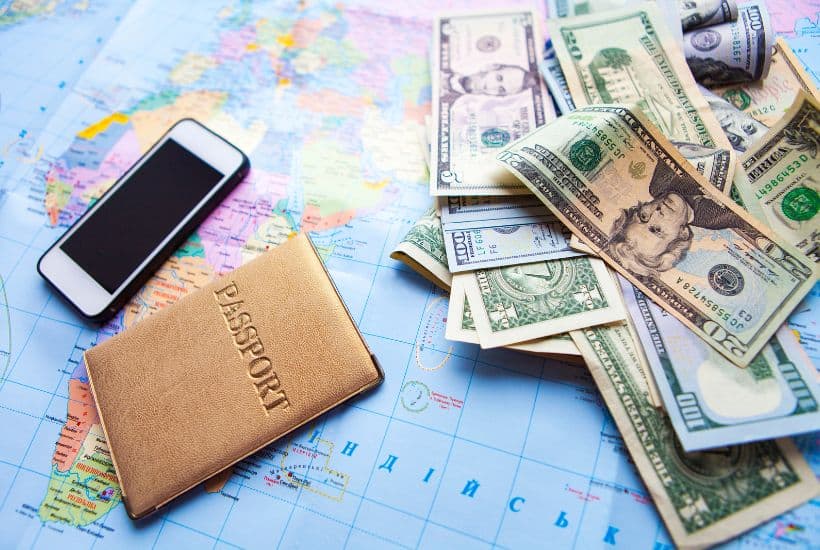Travel Savings: 10 Tips to Afford Your Next Big Trip

One of the main reasons why I hear people say they don’t travel more is because they can’t afford it. If that person sounds a little like you, you’ve come to the right place! I believe that many of us can afford travel and that traveling does not have to be a very large expense. This post on travel savings will walk you through a 10 step process to plan for your trips, so that you can afford the vacations that you’ve always dreamed of taking.
1 | Set a Plan for Your Travels Annually
If taking time to travel is one of your major goals, then it is important for you to set a plan each year for your travels. Now I know that “planning” may sound like the least fun thing to do for some of you, but I can guarantee that it will be great help in meeting your travel goals.
Before you get to setting your actual travel budget, you first need to put some thought around where you will travel and how you will travel. I don’t think that it’s necessary for you to identify specific cities, but it is a good idea to think through which regions you’d like to explore (e.g., Southeast Asia, the Caribbean). A general rule of thumb is that travel costs are similar in similar regions – there are exceptions, of course, but not giving so much specificity will help you have flexibility down the road.
After you put thought to where you want to go, next you should think through “how” you want to travel. Another way to frame this is – what is your travel philosophy? A few questions to help you nail it down are:
- Do you like luxury travel, budget travel, or something in-between?
- Do you value experiencing new places like a local, or do you prefer to stay at resorts?
- Is eating very well an important part of your travel experience? Or do you prefer (or need to) make your food while vacationing?
Once you have your travel philosophy down, you’re ready to move to the next step. And I’ll note, once you get more used to traveling regularly, this part of the planning process will start to take much less time.

2 | Review Your Total Budget (Or Start One)
Your next steps to figuring out your travel savings is to do a very thorough review of your total budget. If you already have a budget in place – great! Best practice would be to take your budget from the past few months (or year if you can) to see what spending trends you’ve had over time.
If you don’t have a budget, NOW is the time to start one. Unsure where to start? Well I recommend trying out the 50/30/20 budget template. As a quick summary, this budget divides your expenses into main categories as defined below:
- 50% – Needs: This category includes those expenses that you can’t avoid. Sample sub-categories include:
- Groceries
- Utilities
- Rent / Mortgage Payments
- Car Payments
- Health Insurance
- Minimum Debt Payments (e.g., Student Loans, Credit Card Debt)
- 30% – Wants: This category includes expenses on the things that make your life richer. Sample sub-categories include::
- Entertainment (Movies, concerts, etc.)
- Cable TV / Streaming Services
- Eating Out
- Travel 😉
- Hobbies
- 20% – Savings/Debt: This category is dedicated to building your wealth. Sample sub-categories include:
- Saving Accounts (Includes building an emergency fund)
- Retirement Accounts
- Investments (ETFs, Stocks, Real Estate, etc.)
- Debt Repayment (Anything greater than the minimum)
As you’re starting your budget for the first time, review your expenses for the past 2-3 months so that you’re able to see trends in your spending habits. And note, for more detailed information on the 50/30/20 Budget, check out this post.
As you review your budget, here are a few questions to ask yourself:
- Do you currently have “free” space in your budget to begin allocating money to travel? Or could I have space if I made some small lifestyle changes?
- Will adding travel as a line item to your budget impact your ability to pay debt and/or meet your personal savings goals?
- Have you accounted for major expenses that will impact me/ my family this year? This would include life events like a wedding, baby, kid starting college, etc.
When you’re done evaluating your spending habits you should have a rough idea of how much money you can safely set aside for travel each month / over the course of the year.
3 | Set Your Annual Travel Budget
Now that you know where you’re going, how you’re going to travel, and how much money you have to allocate towards travel, it’s time to identify your travel savings goals and set your travel budget. The amount that you set aside for the year should account for how much “space” you have in your budget, but there are a few travel budget categories that you should evaluate to make the process slightly more scientific, if you will.
To make your budget most specific, you should estimate costs in the following categories for each country / region you plan to visit over the next year:
- Lodging Expenses: Hotels, Airbnbs, etc.
- Transportation Expenses: Flights, Trains, Public Transportation, Taxis, etc.
- Food Expenses: Meals and snacks
- Cost for Activities: All paid excursions and tours
Do some research on each by using google and travel reservation sites to see how costs vary by the locations you’d like to visit and the type of travel that you’d like to take. Using your initial travel budget, you’ll be able to set a realistic expectation around where you can travel, how many trips you can take, and how much you can spend on each trip.
If you are unhappy with the results – don’t worry! We’ll get into ways to save on travel next.
For more detailed information on how to budget for travel visit this page.
4 | Examine How to Cut Spending
Now it’s time to take a look back at your spending habits from the past few months / year. Where did you overspend? I think that doing a budget review can be so helpful in helping you clearly understand where you can do better.
Depending on what you find when reviewing your expenses, you may have a variety of areas to cut down. If you feel like you have trouble with overspending in many areas, here are some ideas on where you might consider cutting down on your expenses:
How to Save Money on Groceries
- Plan your meals in advance by using a meal plan
- Use coupons when shopping
- Review saving options in services like iBotta to get cashback when you shop
- Shop at grocery stores with better prices, like Aldi or Trader Joe’s (my fave!), and stay away from high-end grocery stores, like Whole Foods (except for very specific and limited purchases)
- Set a weekly grocery budget and stick to it!
- Use the long-shelf grocery items you have in your pantry right now (you know you have them)
- Buy less junk foods, sweets, alcohol – you’re better off without those empty calories anyway

How to Save Money on Utilities
- Turn off appliances you don’t need and lights when you leave the room
- Wash dishes in the dishwasher and limit rinsing beforehand
- Don’t leave on the tap when you aren’t actively using the water
- Don’t leave on the stove or oven longer than you need to
How to Save Money on Housing
- If you are a renter, seek the opportunity to negotiate your rent in advance of renewing any new lease
- Try to pay rent a few months in advance (if you can), as landlords may reduce the rent price in this case
- If you are a homeowner, check with your lender / bank to see if the is a chance for you to refinance for a owner interest rate; which will effectively lower your monthly payments (if the lease term stays the same) – more details on this in the next section
How to Save Money on Transportation
- Don’t take out that loan for an expensive car. I’m here to tell you today that you don’t need it. Cars are depreciating assets, so your money is best spent elsewhere
- Buy used cars instead of purchasing brand new ones
- Keep your car for as long as it works – don’t get rid of it if there is nothing wrong with it. Keeping up with the Joneses will kill your budget
- If you live in an area with great public transportation, consider using public transportation instead of owning a car
- If using public transportation, check with your job to see if you are permitted any pre-tax benefits or subsidies (same goes for parking if you drive and have a parking fee)
- Carpool to work if you can
- Shop around for the best deals on auto-insurance. If you’ve been with the same company for years, it’s likely time for re-evaluation
How to Save Money on Health Insurance
If your employer offers health insurance, check to see if you have the option for a High-Deductible Healthcare Plan (HDHP). These are typically by far the cheapest in terms of out of pocket costs. In addition, you’ll have the option to set up an HSA account, which is a great way to save money for your retirement healthcare expenses.
Note, if you are using the healthplace market in the US, HDHPs are an option for you too!
Related Post | The Ultimate Budget Binder
How to Save Money on Entertainment
- Get rid of your cable expenses and carefully select streaming services that make the most sense for you. I say this because there has definitely been an outpouring of new ones every few months – and I’m sure you don’t need all of them. Also – most services allow several users, so share with your friends and family to cut costs
- Rent books from the library instead of buying them – this applies to audiobooks too — try the Libby app
- If you can take it, wait to watch movies until you can see them at home
Give Yourself a Spending Hiatus
I like to take a few months out of the year to “reset” on spending. For me, that means taking a month off of buying anything that isn’t an actual need. That is no new clothes, accessories, games, fancy foods, or expenses for hobbies. You’d be amazed on how much you can save by taking an approach like this! And if you can make it last longer than a year, you should go for it!
5 | Pay Off High-Interest Debt and Refinance the Rest
Tackling High Interest Debt
One thing you probably haven’t thought of as you consider ways to up your travel savings is tackling your debts. I want to first state that I advise strongly against financing your travels. Just don’t do it! A general principal that you should have for most purchases is that if you can’t buy it with the money in the bank, you don’t have money to afford it (large purchases like homes and cars excepted).
One thing that will hold back your capacity for travel savings is any high-interest debt that you have outstanding. In particular, I’m talking most about credit card debt. With interest rates up to over 20%, credit card debt can be hard to get rid of. If you do have debt of this nature to pay down, paying it down should be your priority.
Also, depending on how much debt you have, consider different repayment strategies. Check out this post on the debt snowball vs. avalanche repayment methods for more information.
Tackling Other Debts
For your other lower-interest debts, one thing to consider is refinancing. If this term is new to you, it’s essentially just getting a new loan on your current loan with the intent on getting a lower interest rate. The two types of loans that people typically refinance are student loans and mortgage loans.
- For student loans, I recommend refinancing with SoFi – they have interest rates that are as low as 2.25%! In addition, you get a lot of great free benefits like financial planning, estate planning, unemployment protection, career services, and more!
- For mortgage loans, I recommend talking with your current lender to learn more on the refinancing process.
6 | Earn More Money
No matter what anyone says, it’s usually not enough to simply save more and handle your money better. If the amount you can save monthly for travel is STILL not enough, now it’s time to start looking at your income. There are two main ways to do that, and we’ll explore that now.

Increase Your Regular Income
First, take a look at the money that you make in your regular jobs. Are you happy with your income? Or should you be earning more. If upward mobility is an option at your current job, talk to your leadership about promotion opportunities. If not an option at your current job, I’d suggest getting started with your search for a new job or even career.
Start a Side-Hustle (or Two)
In addition to increasing your standard income, you should also consider options to improve your income that are fully under your control. Nowadays there are just SO many different ways that you can make money online, and it would be a shame not to take advantage of them. Here are just a few ideas that you might want to consider:
- Teach English Online: It’s easy to meet the requirements and, as you can imagine, the demand for teaching english online is very high. iTalki or VIPkid are great places to start for pursuing this option
- Rent Out Things You Own: There are so many options for renting out things that you own and may not need to use often. Here are a few ideas: (1) Rent out your car using Turo, (2) Rent out your home on Airbnb, (3) Rent out random stuff using Fat Llama, or even (4) Rent out storage space on the Neighbor’s marketplace
- Create an Online Course: If you have a skill that you are always asked about by others, it might be worth selling your knowledge to others. The great thing about creating courses is that after initial setup, the money is pretty passive! One of the best platforms for selling your course today is Teachable – and they even provide free training on how to get started.
- Start a Blog: Starting a blog is an effort that, while not immediately profitable, can lead to real gains in the long run. And if travel is what you are most knowledgeable on, it’s probably a good area for you to focus your blog on. For more information, check out this post on the best tips for starting a blog.
- Do Gig Work Online: If you have a marketable skill, especially in the digital space, considering offering your services for a fee on a platform like Fiverr.
Now, these are just a few of the options you might consider as a side hustle, but if you need more options, take a look at this post on the 50 Best Side Hustle ideas.
7 | Set Up a Travel Savings Account
Now that you have set up your travel budget, know where you can cut costs, and how to bring in additional income, it’s now time to set up a place to put all your travel funds.
There are two considerations for the travel savings account that you set up:
- Separate than your regular bank accounts. I recommend that the account for your travel money be held outside of your regular bank so that you can’t easily use the money for something else. If possible, having the ability to set up auto-deductions to this account would be the best case scenario.
- Able to accrue interest. Who doesn’t like making money on the money that you already have, right? I recommend using a high-interest savings or similar account to stash away all your travel money.
Now keeping these ideas in mind, here are a few idea on where to store your travel cash until you’re ready to spend it:
- Ally High-Interest Savings: The best option for those looking for a standard approach to saving money is using an Ally account. The thing I really like about their savings program is that you can set up “buckets” and allocate your saving accordingly. So if you have other things your saving for outside of travel, you can easily save for those goals as well. Note, as of January 2021, the interest rate is 0.50%, but when the economy is more stable, the rate can reach 2.00%.
- Worthy Bonds: Worthy Bonds are a great way to save at a 5% savings rate (!). And since these are privately owned bonds, you do not have to worry about paying special penalties or fees when using your money. And did I mention – these bonds are fully liquid? Here’s my full review of Worthy Bonds. Sign up today to get your free bond (worth $10)!
- Crypto Stable Coins: So this is certainly the most unconventional method. But hear me out. Did you know that you can make over 10% in interest on stable crypto coins? Essentially, these are crypto coins that are tied to US or other fiat currencies. And as such, there is no volatility at all – unlike Bitcoin and other alt coins.
It is a bit harder to convert your money to cash, but as mentioned above, you do want to keep your travel money safe from your spending habits. Don’t know here to start? Here are a few helpful resources:
- Get details on stable coins and how they work here
- Sign up with Celsius to buy your stable coins, and get an interest rate of up to 10.51%. Also if you use my link, you’ll get an extra $20 for depositing $200
- Sign up with Voyager to buy your stable coins, and get an interest rate of up to 9.5%. If you use my link, you’ll get $25 of Bitcoin after your deposit of $100.
- Learn how to convert your crypto to fiat here
As you can see, there are several options that you can use to put away all your travel funds. You can simply choose the option that works best for you / makes you most comfortable.
8 | Examine Ways to Reduce Travel Costs
So when it comes to planning the itinerary for each of your trips in detail, I highly recommend that you take a detailed look at how to reduce costs for your trip. Here are my favorite ways to reduce spending on travel.
Use a Travel Credit Card
Travel credit cards are really one of the key ways to save money on your travel expenses. There are a variety of travel cards on the market today, but I personally believe that the Chase Sapphire Reserve or Chase Sapphire Preferred are the absolute best travel cards on the market today.
There are two key reasons for this evaluation:
(1) 1 point within the Chase Ultimate Rewards Platform is worth more than the majority of credit card points on the market today. The only comparable card family is American Express, as of 2021.
(2) The Ultimate Rewards Platform provides a discount for any flights or hotels purchased through their platform using points – with the Preferred, your points are worth 25% more and with the Reserve, your points are worth 50% more.
These two points alone really up the value that these cards provide. In addition, if you pursue the Chase Gauntlet by pairing these cards with other Chase products, such as the Chase Freedom and the Chase Freedom Unlimited, you’ll earn credit card points quite fast.
One recommendation here – It’s best to use the points for flights (vs. credit cards), unless you are really into luxury-level stays. If not, it’s easy to find nice digs for reasonable prices, and we’ll talk about this in more depth below.
One BIG caveat here: when using credit cards for points you CANNOT keep a balance. If you do, you’ll completely negate the savings you gain from points via interest payments. If you are unable to curb spending when using credit cards, this strategy is not for you.

Examine Cost-Cutting Strategies in Each Travel Category
Now, let’s take a look at how you can reduce expenses in each area of your travel budget: Lodging, Transportation, Activities, and Food. One thing I’ll note is that for each of these categories, one common money-saving theme you’ll see is comparison shopping – never buy what you see first!
How to Reduce Lodging Expenses
When looking for the best place to stay, you should research the best neighborhoods to stay and work your way out from there. As you can imagine, it’s typically most expensive to stay in the most popular neighborhoods, but if you know where they are, then you’ll be able to identify nearby locations that allow for easy access to the popular destinations.
Next, start a search for Airbnbs in your desired area. I know some have strong opinions on it, but Airbnb is still the best way to find nice and affordable lodging. This is particularly true in Europe and in large cities in the US.
When traveling to less developed areas, hotels may be your best bet. And in this case, they are usually pretty affordable. I search for all of my hotel stays on sites like Booking.com and Agoda.
Booking.comHow to Reduce Transportation Expenses
How to Save Money on Flights
The biggest transportation expense is flights – by far. The best way to save on your flights is to use travel points to greatly reduce costs here. I’ve become so efficient with collecting and using points that I usually only pay for about half of the trips that I take each year. And this is something that you can do too.
If you aren’t able to use points just yet, and have to travel before you can accrue them, here are a few sites that you can use to help find the lowest fares:
How to Save Money on Taxis, Ubers, or Cars
Depending on where you visit this can be the most cost-effective method for you to travel around. But there are a few pointers you should definitely keep in mind as you research the best way to get around:
- Airport Rides: I make it a rule of thumb to never purchase a ride from anyone loitering in the airport exit. Typically these are the most expensive methods to leave the airport. Either get into the taxi line, purchase your ride in advance, or take an uber
- Hiring a Driver: In countries where costs are relatively low, it may be cost efficient for you to hire someone to drive you around for the duration of your trip. For example, when I traveled to Ghana last year, my friends and I hired a driver for a week and only spent ~$80/ each.
- Ubers: When available, ubers are usually the best option, especially in countries where taxi prices are “negotiable”.
How to Save Money on Public Transportation
There are fewer hacks in this category than others, but some cities offer something like a “travelers pass”, permitting you discounted prices for a short period of time. A few examples are the Roma Pass and the Lisboa Pass, for reference.
How to Save Money on Food
The best way to save money on food while you travel is to buy from the grocery store and make your own food. This is not usually my favorite option, but it has come in handy in places like Iceland, where restaurant prices are quite high (but groceries are relatively cheap). Of course, this is typically only an option if you’re staying somewhere with a fridge and a stovetop.
If cooking is not an option (or you really prefer to eat local food), then it’s best to just do your research in advance. Look into average prices and understand where you can go for a cheap, but good, meal. And also where you can splurge for an excellent meal every now and then.
How to Save Money on Activities
The best way to save money is to do as many self-guided tours and activities as you can. There are apps like this one by Rick Steves, that make the self-guided process very easy.
Another way to save is to shop around between sites like Viator and GetYourGuide for the best price on popular tours. You’d be surprised at how much prices can vary between the two platforms (or between operators in both platforms).

How to Save Money on Souvenirs
To save on just general spending, set a cash budget for yourself each day and let that limit what you spend. It will make you a better bargainer and will be a physical reminder that you have no money left to spend.
Personally, I have no issue with spending with credit cards when I’m at home and staying in check, but vacation money is a whole different story. I think it may have something to do with poorly calculating exchange rates.
9 | Re-Examine Your Progress
The best way to make sure you don’t get off track is to regularly review your spending habits. In addition to tracking your budget every week or two, you should examine your spending trends every 1-2 months. This will allow you to make tweaks on demand so that you don’t get off track in reaching your travel savings goals.
10 | Monitor Expenses During Your Trip
The final step is to actually monitor your expenses while you are traveling. I’ve built a travel budget that helps you with estimating your expenses per the number of days you travel. And since you can access it in Google Sheets, you have the ability to make live edits wherever you have internet access. The more money that you can save on each trip, the more you’ll have left over for the next one.
Information on how to download the Travel Budget for free is below!
Related Posts | How to Make a Travel Budget
Frequently Asked Questions about Saving for Travel
People afford to travel through various means, such as saving money, budgeting, using travel rewards, finding affordable accommodations, and prioritizing travel in their expenses.
To save money for traveling, consider creating a dedicated travel fund, cutting unnecessary expenses, setting a budget, and exploring additional income sources.
Some banks or financial institutions offer travel savings accounts designed to help individuals save specifically for travel, but availability may vary depending on your location and financial institution. Ally Bank or Sofi Money are some relevant options with special saving account buckets.
Whether $5,000 is enough for a vacation depends on factors like the destination, duration, travel style, and personal spending habits. It might be enough for a budget trip but might not cover luxury vacations.
$20,000 can be enough to travel the world for some individuals, especially if they plan a frugal journey, stay in affordable accommodations, and visit less expensive countries. However, it might not be sufficient for an extravagant or extended trip with high-end expenses.
Travel Savings | Putting It All Together
That wraps this post on the 10 best ways to boost your travel savings. As a reminder here is a summary of the steps:
- Plan your travels out for the year
- Review your budget for change opportunities
- Set your annual travel budget
- Examine how to cut expenses out of your budget
- Pay off high-interest debts
- Earn more money
- Set up a travel savings account
- Examine ways to reduce travel costs
- Re-examine your spending progress
- Monitor expenses while you travel
Do you have any other great trips for saving more for travel? If so, let me more in the comments below!

